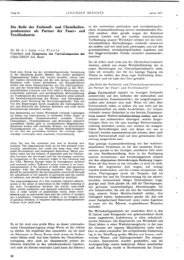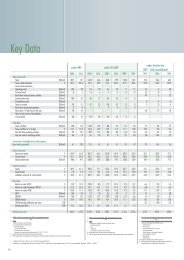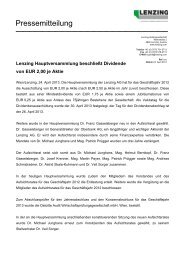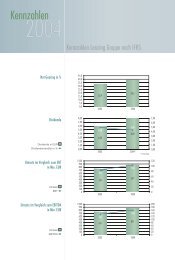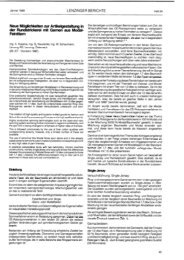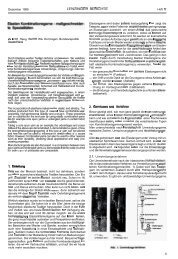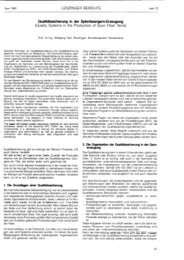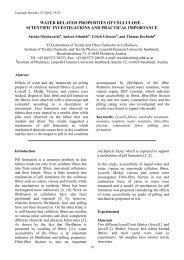THE SORPTION BEHAVIOUR OF CELLULOSE FIBRES - Lenzing
THE SORPTION BEHAVIOUR OF CELLULOSE FIBRES - Lenzing
THE SORPTION BEHAVIOUR OF CELLULOSE FIBRES - Lenzing
Create successful ePaper yourself
Turn your PDF publications into a flip-book with our unique Google optimized e-Paper software.
Table 1. Specifications and structure characteristics of regenerated cellulose fibres [1]], [2].<br />
Fibre type Viscose Modal Lyocell<br />
Symbol CV CMD CLY<br />
Linear density Tt [dtex] DIN 53 812 1.88 ±0.15 1.78 ±0.23 1.82 ±0.30<br />
Fibre length l [mm] DIN 53 808 39.9 ±0.51 40.1 ±0.33 39.4 ±0.44<br />
Fibre diameter d [µm] DIN 53 811 14.3 ±1.39 14.2 ±1.10 12.8 ±1.00<br />
Density ρ [g/cm 3 ] DIN 53 479 1.5045 1.5141 1.5205<br />
Degree of polymerisation DP DIN 54 270 235 ±5.13 507 ±3.61 642 ±4.58<br />
Molecular mass M DIN 54 270 38005 ±881 82097 ±538 104021 ±730<br />
Crystallinity index CrI * 0.25 0.37 0.44<br />
Orientation factor f ∆n ** 0.58 ±0.07 0.69 ±0.08 0.71 ±0.04<br />
Void volume Vp [cm 3 /g] *** 0.68 0.49 0.62<br />
30<br />
* Determined by X-ray wide angle diffraction (2θ = 5° - 45°)<br />
** From birefringence measurements of the fibres<br />
*** Determined by size exclusion chromatography [[18],[19],[20],[21]]<br />
Table 2: The specifications of investigated<br />
natural cellulose fibres.<br />
Fibre type Cotton<br />
Symbol Co<br />
Degree of polymerisation DPη<br />
Metal content [ppm/0.5 g fibres]<br />
4700±34.3<br />
Mg<br />
249<br />
Fe<br />
39.4<br />
Mn<br />
1.26<br />
Zn<br />
20.2<br />
Methods. Moisture sorption of fibres was determined<br />
according to standard DIN 54 351. Cellulose<br />
fibres were exposed to standard atmosphere<br />
20 ±2°C, 65% ±2% RH for 24 hours (DIN 53<br />
802). Moisture sorption was calculated as a mass<br />
% of absolute dry material (T = 105°C, t = 4<br />
hours).<br />
Water retention power of cellulose fibres was<br />
determined according to standard DIN 53 814.<br />
This method is based on a determination of the<br />
quantity of water, which the fibres can absorb<br />
and retain under strictly controlled conditions.<br />
This property is expressed as a ratio between the<br />
mass of water retained in the fibre after soaking<br />
(2 hours) and centrifuging (20 min), and the<br />
mass of absolute dry sample (T = 105°C, t = 4<br />
hours).<br />
Swelling of the cellulose fibres in the aqueous<br />
medium was determined on the basis of fibre<br />
diameter measurements. Applied equipment:<br />
fibre diameter measurements were carried out<br />
with the Axiotech 25 HD microscope using the<br />
image analysis system and supporting Kontron<br />
KS 300 software.<br />
Electrokinetic properties of fibres were analysed<br />
by zeta potential ζ measurements, which were<br />
determined by streaming potential measurements<br />
as a function of the pH. It has been shown that<br />
the streaming potential measurement is the most<br />
appropriate electrokinetic technique for studying<br />
electrokinetic properties i.e. the zeta potential (ζ)<br />
of fibres systems [[16],[17]]. The ζ was calculated<br />
from the streaming potential (Us) data using<br />
the Smoluchowski equation. The channel′s<br />
geometry was taken into account according to<br />
Fairbrother and Mastin [[22]]. This measurements<br />
were always performed in a fibre cell using<br />
0.001 n KCl as electrolyte solution. The pH<br />
of the electrolyte solution was always varied in<br />
an identical way. It was first adjusted to pH 10<br />
using 0.1 n NaOH and then decreased gradually<br />
with 0.1 n HCl. The here mentioned zeta potential<br />
values were always those obtained at the<br />
constant part of the zeta potential - pH function<br />
in the alkaline region at pH = 9. Applied equipment:<br />
Electrokinetic Analyzer EKA, A. Paar KG.



